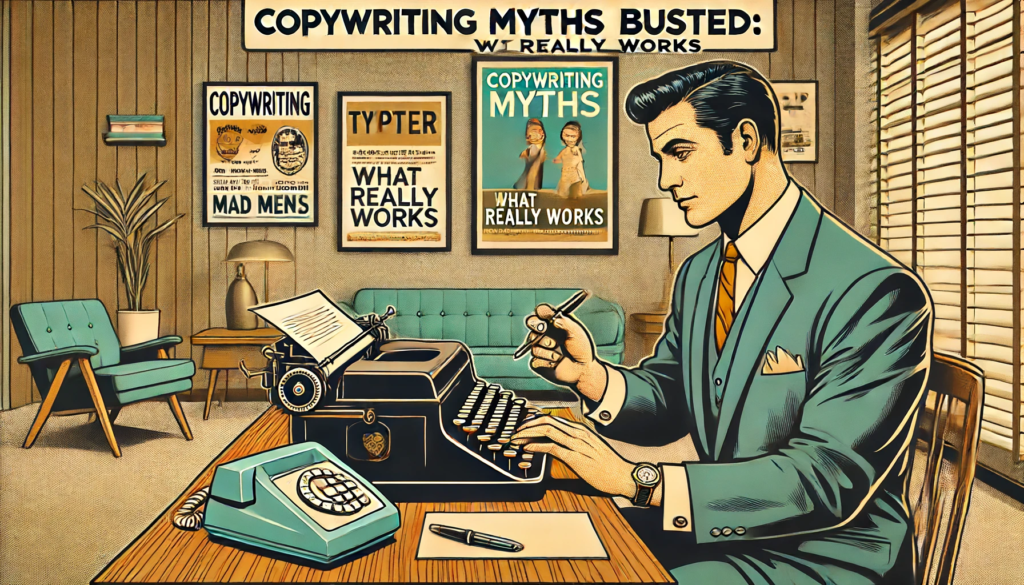There’s no shortage of advice out there when it comes to copywriting.
Everyone has an opinion, and it seems like new “rules” pop up every day. But how much of this advice is actually true?
Today, we’re diving into some of the most common copywriting myths and revealing what really works, so prepare to have your assumptions challenged and your copywriting skills sharpened 🙂
In this article, you will discover…
- Why “long copy doesn’t work” is a myth…
- The truth about the importance of grammar in copywriting…
- Why writing for everyone is a surefire way to connect with no one…
- The myth that you need to be a natural-born writer to succeed…
- How to truly measure the effectiveness of your copy…
Plus, much more, including “PRO LEVEL” insights that will transform your understanding of what makes copy effective!
Are You Ready to Uncover the Truth? Let’s Go!!!
Myth #1: Long Copy Doesn’t Work
One of the most pervasive myths in copywriting is that long copy doesn’t work. The idea is that people have short attention spans and won’t read lengthy content. While it’s true that attention spans are shorter in the digital age, dismissing long copy outright is a mistake.
The reality is, length is determined by the nature of the product and the interest of the audience. If you’re selling a complex or high-ticket item, detailed information is necessary to build trust and answer all potential objections. As David Ogilvy famously said, “The more you tell, the more you sell.” The key is to keep your copy engaging and valuable throughout. If your content is compelling, readers will stick around.
To make long copy effective, break it up with subheadings, bullet points, and visuals. This makes it easier to digest and keeps the reader engaged. Test different lengths and see what works best for your audience and product.
Myth #2: Grammar Rules Are Paramount
“Perfect grammar is essential for effective copy.” You’ve probably heard this one before. While grammar is important for clarity and professionalism, sticking rigidly to all grammar rules can actually hinder your copy’s effectiveness.
Copywriting is about communication, not perfection. Sometimes, breaking a few grammar rules can make your copy more conversational and relatable. Contractions, sentence fragments, and even starting sentences with “and” or “but” can make your copy sound more natural and engaging.
Ultimately, the goal is to write the way people speak, not the way they write formal essays. Of course, you shouldn’t throw grammar out the window completely. Avoid glaring errors that could confuse readers or make you look unprofessional. But don’t be afraid to bend the rules if it makes your copy more effective and engaging.
Myth #3: Write for Everyone
“Your copy should appeal to everyone.” This myth is one of the quickest ways to dilute your message and connect with no one. Effective copywriting is about understanding and targeting a specific audience. When you try to please everyone, your message loses impact.
Identify your ideal customer and tailor your message to their needs, desires, and pain points. Use language and examples that resonate with them specifically. This focused approach makes your copy more compelling and effective. Remember, it’s better to deeply connect with a smaller audience than to vaguely address a larger one.
Creating detailed buyer personas can help you get to know your audience better. These personas should include demographic information, interests, challenges, and buying behavior. The more you understand your audience, the more targeted and effective your copy will be.
Myth #4: You Need to Be a Natural-Born Writer
Many people believe that you need to be a natural-born writer to be successful in copywriting. This couldn’t be further from the truth. Copywriting is a skill that can be learned and honed over time, regardless of your background.
What matters most is understanding the principles of persuasive writing and practicing regularly. Read successful copy, analyze what works, and apply those techniques to your own writing. Over time, you’ll develop your own style and voice.
Don’t be discouraged if you don’t consider yourself a “writer.” Focus on the basics—understanding your audience, crafting compelling messages, and continually improving. With persistence and dedication, anyone can become a skilled copywriter.
Myth #5: The Effectiveness of Copy Is Measured by Creativity
Creativity is important, but it’s not the ultimate measure of effective copy. The primary goal of copywriting is to drive action—whether that’s making a purchase, signing up for a newsletter, or clicking a link. Sometimes, the most creative copy isn’t the most effective.
Effective copy is clear, persuasive, and action-oriented. It communicates the benefits of a product or service in a way that resonates with the target audience. Creativity should serve this purpose, not overshadow it.
Measure the effectiveness of your copy by tracking key performance indicators (KPIs) like conversion rates, click-through rates, and engagement metrics. These tangible results are the true indicators of how well your copy is performing.
Test different approaches and use data to inform your strategy.
Overcoming Common Pitfalls: Pro Tips for Effective Copywriting
Now that we’ve debunked some common myths, let’s look at a few pro tips to ensure your copy stands out and drives results.
1. Start with a Strong Hook: The first few sentences of your copy are crucial. Use a compelling hook to grab attention and entice the reader to keep going. This could be a surprising fact, a provocative question, or a bold statement.
2. Focus on Benefits, Not Features: Your audience doesn’t care about the features of your product—they care about what those features can do for them. Always translate features into benefits that address your audience’s needs and desires.
3. Use Social Proof: Testimonials, case studies, and user-generated content are powerful tools for building credibility and trust. Showcasing positive experiences from real customers can significantly boost your copy’s persuasive power.
4. Edit Ruthlessly: Great copy isn’t written—it’s rewritten. Edit your work ruthlessly to eliminate fluff, improve clarity, and enhance readability. Read your copy out loud to catch awkward phrasing and ensure a natural flow.
5. Test and Optimize: Copywriting is both an art and a science. Test different versions of your copy to see what resonates best with your audience. Use A/B testing, gather feedback, and continually optimize based on performance data.
Now, I can hear you thinking, “Robert, this sounds great, but I’m not ready to do this myself.”
Hey, that is OKAY. This stuff takes time to master, but…
You Do NOT Have to Do Any of This Yourself!!!
As a freelance direct response copywriter and copywriting coach, I have spent over 8 years becoming an expert in effective copywriting. In fact, I have helped businesses of all sizes all over the world increase their sales and profits through these strategies.
Now, I am VERY picky about who I work with and the types of projects I take on. I’m also NOT cheap (but worth every penny IMO). And I tend to often be booked MONTHS in advance, so rush jobs are never an option.
With that said, I am ALWAYS looking to connect with anyone who might need my help.
So, let’s talk about what’s going on in your business and life. Head on over to my contact page where you’ll find out how to get in touch with me.
And if you want to learn more about my copywriting services, feel free to CLICK HERE NOW to find out what I have to offer. No promises, but it MAY lead to helping you enjoy more sales, bigger profits, and new levels of success.
ABOUT ROBERT SEAN PASCOE
Robert Sean Pascoe is a direct response copywriter and marketing strategist who works with entrepreneurs worldwide to create advertising and marketing campaigns that MAXIMIZE their profits.
He LOVES Rock N Roll, pro wrestling, Star Wars and pretty much ANYTHING 1980’s.
With 7 years of freelance copywriting experience and a lifetime in sales, Robert knows how to use the power of words to sell virtually anything to anyone, especially if the market has been properly defined (and you BETTER have that right!).
Robert enjoys primarily working with small business owners to sell more of their products and services through the power of direct response advertising and marketing.
He has written sales copy for companies in such diverse niches as Weight Loss Supplements, Skin Care, Male Enhancement, Local Marketing Agencies, Live Event Seminars, Software Developers, Insurance Agencies, Real Estate Brokerages, Marketing Consultants, and many more.




